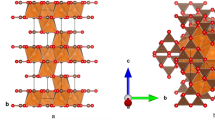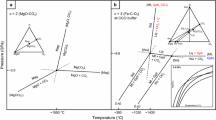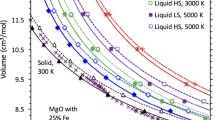Abstract
A semiempirical equation of state was derived for magnesite under the thermodynamic conditions of the Earth’s mantle. Within experimental uncertainties, it is consistent with thermochemical, ultrasonic, X-ray, and shock-wave data at temperatures from 15 K to the melting point and pressures of up to 100–130 GPa. The following values were recommended for the isothermal bulk modulus and its pressure derivative: K T = 111.71 GPa and K′ = 4.08. Thermodynamic analysis showed that magnesite does not decompose to periclase and CO2 under the thermodynamic conditions of the Earth’s lower mantle and outer core.
Similar content being viewed by others
References
T. Katsura, Y. Tsuchida, E. Ito, et al., “Stability of Magnesite under the Lower Mantle Conditions,” Proc. Japan Acad. Ser. B, Phys. Biolog. Sci. 67, 57–60 (1991).
M. Isshiki, T. Irifune, K. Hirose, et al., “Stability of Magnesite and Its High-Pressure Form in the Lowermost Mantle,” Nature 427, 60–64 (2004).
N. V. Skorodumova, A. B. Belonoshko, L. Huang, et al., “Stability of the MgCO3 Structures under Lower Mantle Conditions,” Am. Mineral. 90, 1008–1011 (2005).
L. Liu, “Effects of CO2 on the Phase Behavior of the Enstatite-Forsterite System at High Pressures and Temperatures,” Phys. Earth Planet. Inter. 146, 261–272 (2004).
O. L. Kuskov and N. I. Khitarov, Thermodynamics and Geochemistry of the Core and Mantle of the Earth (Nauka, Moscow, 1982) [in Russian].
Yu. I. Sidorov, “Mathematical Simulation of Complex Natural Systems,” Geokhimiya, No. 1, 103–106 (2006) [Geochem. Int. 44, 94–108 (2006)].
V. B. Polyakov and O. L. Kuskov, “Internally Consistent Model for the Calculation of Thermoelastic and Calorimetric Properties of Minerals,” Geokhimiya, No. 7, 1096–1121 (1994).
T. V. Gerya, K. K. Podlesskii, L. L. Perchuk, et al., “Equation of State of Minerals for Thermodynamic Databases Used in Petrology,” Petrologiya 6, 563–578 (1998) [Petrology 6, 511–526 (1998)].
T. V. Gerya, K. K. Podlessky, L. L. Perchuk, and W. V. Maresch, “Semi-Empirical Gibbs Free Energy Formulations for Minerals and Fluids for Use in Thermodynamic Databases of Petrological Interest,” Phys. Chem. Minerals 31, 429–455 (2004).
J. Hama and K. Suito, “Thermoelastic Models of Minerals and the Composition of the Earth’s Lower Mantle,” Phys. Earth Planet. Inter. 125, 147–166 (2001).
L. Stixrude and C. Lithgow-Bertelloni, “Thermodynamics of Mantle Minerals-I. Physical Properties,” Geophys. J. Int. 162, 610–632 (2005).
P. I. Dorogokupets, “Critical Analysis of Equations of State for NaCl,” Geochem. Int. 40, S132–S144 (2002).
P. I. Dorogokupets and A. R. Oganov, “Equations of State of Cu and Ag and Revised Ruby Pressure Scale,” Dokl. Akad. Nauk 391, 515–518 (2003) [Dokl. Earth Sci. 391, 854–857 (2003)].
P. I. Dorogokupets and A. R. Oganov, “Equations of State of Al, Au, Cu, Pt, Ta, and W and Revised Ruby Pressure Scale,” Dokl. Akad. Nauk 410, 239–243 (2006) [Dokl. Earth Sci. 410, 1091–1095 (2006)].
P. I. Dorogokupets and A. R. Oganov, “Ruby, Metals, and MgO as Alternative Pressure Scales: A Semiempirical Description of Shock-Wave, Ultrasonic, X-Ray, and Thermochemical Data at High Temperatures and Pressures,” Phys. Rev. B 75, Art. No 024115 (2007).
S. V. Churakov, “Thermoelastic Properties of Solid Phases: C++ Object Oriented Library ’solidEOS’,” Comp. Geosci. 31, 786–791 (2005).
T. J. B. Holland and R. Powell, “An Internally Consistent Thermodynamic Data Set for Phases of Petrological Interest,” J. Metamorph. Geol. 16, 309–343 (1998).
V. N. Zharkov and V. A. Kalinin, Equations of State for Solids at High Pressures and Temperatures (Nauka, Moscow, 1968; Consultants Bureau, New York, 1971).
P. Vinet, J. Ferrante, J. H. Rose, and J. R. Smith, “Compressibility of Solids,” J. Geophys. Res. 92, 9319–9325 (1987).
L. V. Al’tshuler, S. E. Brusnikin, and E. A. Kuz’menkov, “Isotherms and Gruneisen Functions for 25 Metals,” Prikl. Mekh. Tekh. Fiz. 161, 134–146 (1987).
A. R. Oganov and P. I. Dorogokupets, “Intrinsic Anharmonicity in Thermodynamics and Equations of State of Solids,” J. Phys. Condens. Matter. 16, 1351–1360 (2004).
P. I. Dorogokupets and A. R. Oganov, “Intrinsic Anharmonicity in Equations of State of Solids and Minerals,” Dokl. Akad. Nauk 395, 804–807 (2004) [Dokl. Earth Sci. 395, 238–241 (2004)].
W. B. Holzapfel, “Effects of Intrinsic Anharmonicity in the Mie-Gruneisen Equation of State and Higher Order Corrections,” High Pressure Res. 25, 187–203 (2005).
B. S. Hemingway, R. A. Robie, J. R. Fisher, and W. H. Wilson, “Heat Capacities of Gibbsite, Al(OH)3, between 13 and 480 K and Magnesite, MgCO3, between 13 and 380 K and Their Standard Entropies at 298.15 K, and Heat Capacities of Calorimetry Conference Benzoic Acid between 12 and 316 K,” J. Res. U.S. Geol. Surv. 5, 797–806 (1977).
R. A. Robie, B. S. Hemingway, and J. R. Fisher, “Thermodynamic Properties of Minerals and Related Substances at 298.15 K and 1 Bar (105 Pascals) Pressures and at Higher Temperatures,” U.S. Geol. Surv. Bull., No. 1452 (1978).
S. A. Markgraf and R. J. Reeder, “High-Temperature Structure Refinements of Calcite and Magnesite,” Am. Mineral. 70, 590–600 (1985).
N. I. Christensen, “Elastic Properties of Polycrystalline Magnesium, Iron, and Manganese Carbonates to 10 Kilobars,” J. Geophys. Res. 77, 369–372 (1972).
P. Hubert and F. Plicque, “Proprietes elastiques de carbonates rhombohedriques monocristallins: calcite, magnesite, dolomite,” C. R. Acad. Sci. Paris 275, 391–304 (1972).
P. Gillet, “Stability of Magnesite (MgCO3) at Mantle Pressure and Temperature Conditions: A Raman Spectroscopic Study,” Am. Mineral. 78, 1328–1331 (1993).
G. Fiquet, F. Guyot, and J. P. Itie, “High-Pressure X-Ray Diffraction Study of Carbonates: MgCO3, CaMg(CO3)2, and CaCO3,” Am. Mineral. 79, 15–23 (1994).
G. Fiquet and B. Reynard, “High-Pressure Equation of State of Magnesite: New Data and a Reappraisal,” Am. Mineral. 84, 856–860 (1999).
G. Fiquet, F. Guyot, M. Kunz, et al., “Structural Refinements of Magnesite at Very High Pressure,” Am. Mineral. 87, 1261–1265 (2002).
N. L. Ross, “The Equation of State and High-Pressure Behavior of Magnesite,” Am. Mineral. 82, 682–688 (1997).
J. Zhang, I. Martinez, F. Guyot, and P. Gillet, “X-Ray Diffraction Study of Magnesite at High Pressure and High Temperature,” Phys. Chem. Minerals 24, 122–130 (1997).
N. G. Kalashnikov, M. N. Pavlovskii, G. V. Simakov, and R. F. Trunin, “Dynamic Compressibility of Calcite Group Minerals,” Izv. Akad. Nauk SSSR, Fiz. Zemli, No. 2, 23–29 (1973).
J. Matas, O. Gillet, Y. Ricard, and I. Martinez, “Thermodynamic Properties of Carbonates at High Pressures from Vibrational Modeling,” Eur. J. Mineral. 12, 703–720 (2000).
L. V. Gurvich, I. V. Veits, V. A. Medvedev, et al., Thermodynamic Properties of Individual Substances (Nauka, Moscow, 1978–1982), Vols. 1–4 [in Russian].
S. A. T. Redfern, B. J. Wood, and C. M. B. Henderson, “Static Compressibility of Magnesite to 20 GPa: Implications for MgCO3 in the Lower Mantle,” Geophys. Res. Lett. 20, 2099–2120 (1993).
H. K. Mao, P. M. Bell, J. W. Shaner, and D. J. Steinberg, “Specific Volume Measurements of Cu, Mo, Pd, and Ag and Calibration of the Ruby R1 Fluorescence Pressure Gauge from 0.06 to 1 Mbar,” J. Appl. Phys. 49, 3276–3283 (1978).
L. Vocadlo, “First Principles Calculations on the High-Pressure Behavior of Magnesite,” Am. Mineral. 84, 1627–1631 (1999).
A. Belonoshko and S. K. Saxena, “A Molecular Dynamic Study of the Pressure-Volume-Temperature Properties of Supercritical Fluids: CO2, CH4, CO, O2, and H2,” Geochim. Cosmochim. Acta 55, 3191–3208 (1991).
S. V. Churakov and M. Gottschalk, “Perturbation Theory Based Equation of State for Polar Molecular Fluids: I. Pure Fluids,” Geochim. Cosmochim. Acta 67, 2397–2414 (2003).
A. J. Irving and P. J. Wyllie, “Melting Relationships in CaO-CO2 and MgO-CO2 to 36 Kilobars with Comments on CO2 in the Mantle,” Earth Planet Sci. Lett. 20, 220–225 (1973).
A. R. Oganov, C. W. Glass, and S. Ono, “High-Pressure Phases of CaCO3: Crystal Structure Prediction and Experiment,” Earth Planet. Sci. Lett. 241, 95–103 (2006).
Author information
Authors and Affiliations
Additional information
Original Russian Text © P.I. Dorogokupets, 2007, published in Geokhimiya, 2007, No. 6, pp. 624–631.
Rights and permissions
About this article
Cite this article
Dorogokupets, P.I. Equation of state of magnesite for the conditions of the Earth’s lower mantle. Geochem. Int. 45, 561–568 (2007). https://doi.org/10.1134/S0016702907060043
Received:
Issue Date:
DOI: https://doi.org/10.1134/S0016702907060043




